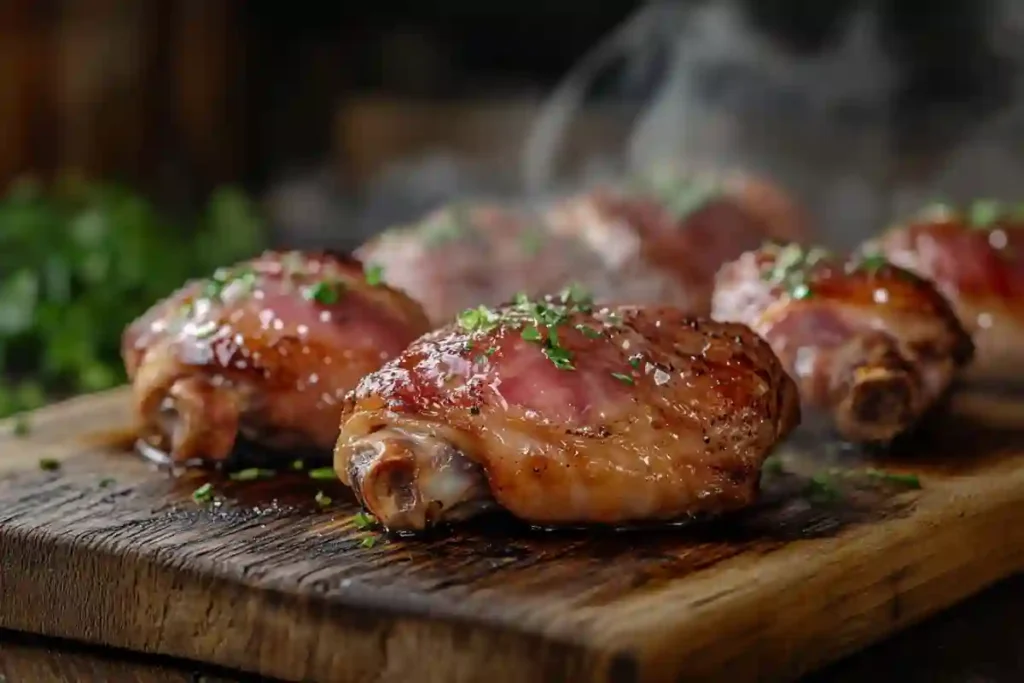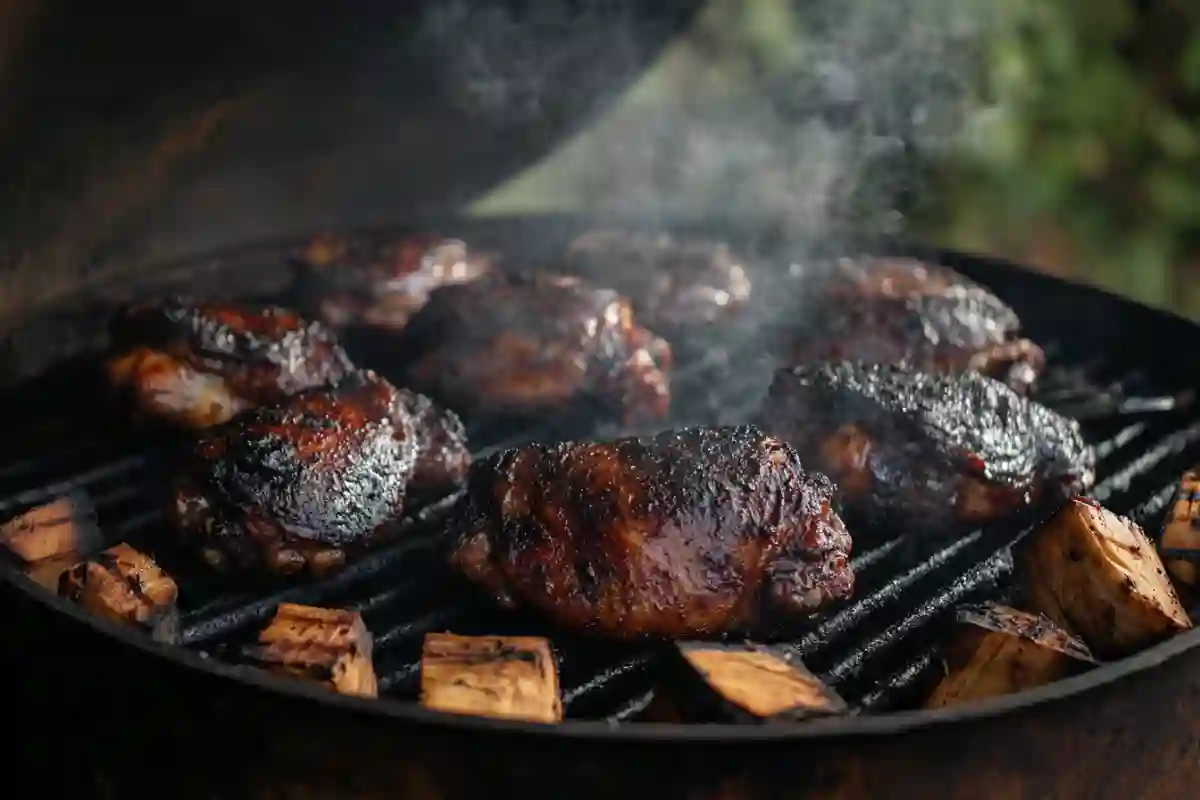Smoked chicken thighs are a flavorful delight, often leaving many cooks curious about their signature pink hue. This article explores why smoked chicken thighs might appear pink, whether it’s safe, and how to prepare them to perfection.
Understanding the Pink Color in Smoked Chicken Thighs
One of the most common questions among barbecue enthusiasts is whether smoked chicken thighs should appear pink. This vibrant color can be confusing, especially for those associating pink meat with undercooking. However, the pinkish hue in smoked chicken is not necessarily a sign of undercooked meat. Let’s explore the science and artistry behind this phenomenon.
Why Are Smoked Chicken Thighs Pink?
The pink coloration in smoked chicken thighs occurs due to a combination of natural and chemical factors unique to the smoking process. First, the protein myoglobin, present in chicken muscle tissue, plays a significant role. Myoglobin is responsible for the red or pinkish color in raw meat and reacts to heat and smoke differently than other proteins. When wood is burned during smoking, it releases nitrites and nitrates. These compounds bind to myoglobin, stabilizing its color and preventing it from turning entirely white as it would in traditional cooking methods like baking or grilling.

Additionally, the temperature and duration of smoking heavily influence this pink hue. Lower smoking temperatures, typically between 200°F and 250°F, allow for prolonged exposure to smoke. This enables the smoky compounds to penetrate deeply into the meat, enhancing both flavor and the pink color. However, the color isn’t evenly distributed—it’s most noticeable near the surface of the meat, where the smoke interacts directly. It’s a fascinating chemical interplay that creates a distinctive and appealing look.
Furthermore, certain wood types used for smoking, like hickory or applewood, contribute more intensely to the pink appearance compared to others. They release higher levels of nitrogen dioxide, which amplifies the reaction with myoglobin. These details emphasize why the pink color isn’t just a byproduct of cooking but a key aspect of smoked chicken’s character.
How to Ensure Smoked Chicken Thighs Are Fully Cooked
While the pink hue is a desirable trait in smoked chicken, ensuring it is safe to eat remains crucial. Cooking chicken improperly can lead to foodborne illnesses, which is why understanding safe practices is vital. The most reliable way to confirm doneness is by using a meat thermometer. Insert the thermometer into the thickest part of the chicken thigh, ensuring it doesn’t touch the bone, as this can give an inaccurate reading. The USDA mandates that chicken be cooked to an internal temperature of 165°F (74°C) to eliminate harmful bacteria.
It’s also helpful to monitor the appearance of the juices. Properly cooked chicken releases clear juices when cut or pierced. If the juices appear reddish or pink, it’s an indicator that the meat requires further cooking. Another method is the texture test—fully cooked chicken should feel firm but not rubbery to the touch. Experienced pitmasters often use a combination of these techniques for consistency.
Moreover, the type of smoker and cooking method you use can impact the safety and color of the chicken. For instance, pellet smokers and offset smokers provide more even heat distribution, ensuring thorough cooking. These tools allow for better temperature control, reducing the risk of undercooking. This careful attention to detail ensures that your smoked chicken thighs not only look and taste great but are safe for everyone to enjoy.
The Role of the Smoke Ring in Chicken Thighs
The “smoke ring” is a term often used in barbecue circles to describe the visible pink layer just beneath the surface of smoked meat. While it’s more commonly associated with beef and pork, chicken thighs can also develop this feature. The smoke ring is formed when nitrogen dioxide from the burning wood interacts with the meat’s surface and binds with water molecules. This reaction creates nitric acid, which stabilizes the pink pigment in the outer layer of the meat.
The depth and intensity of the smoke ring depend on various factors, including the duration of smoking, the moisture content of the chicken, and the type of wood used. For example, mesquite and hickory woods are known to produce deeper smoke rings compared to lighter woods like alder or cherry. Interestingly, the smoke ring is purely aesthetic and doesn’t affect the flavor of the meat. However, it’s often seen as a hallmark of skilled smoking and adds to the visual appeal of the dish.
For those new to smoking, achieving a pronounced smoke ring might take some practice. Factors such as maintaining a consistent temperature, ensuring adequate air circulation, and keeping the meat moist throughout the cooking process all contribute to this effect. While not a mandatory feature, the smoke ring is a point of pride for many barbecue enthusiasts and adds to the allure of smoked chicken thighs.
Does the Pink Color Impact Flavor?

The pink hue in smoked chicken thighs is not just visually appealing—it also hints at the depth of flavor imparted by the smoking process. Unlike grilled or oven-roasted chicken, smoked chicken develops a complex taste profile thanks to the prolonged exposure to wood smoke. The pink color, often accompanied by a crispy, golden-brown skin, serves as an indicator of the meat’s ability to absorb smoky flavors deeply.
The flavor profile of smoked chicken thighs varies depending on the type of wood used. For instance, fruitwoods like apple or cherry impart a mild, sweet flavor that complements chicken’s natural taste. In contrast, hardwoods like hickory and mesquite produce stronger, bolder flavors. This versatility allows cooks to tailor the smoking process to their taste preferences while still achieving that signature pink color.
Additionally, the pink hue often correlates with the juiciness of the meat. Properly smoked chicken thighs retain more moisture than other cooking methods, thanks to the low and slow heat. This combination of tender meat, smoky flavor, and vibrant color makes smoked chicken thighs a standout dish, perfect for impressing guests or enjoying a hearty meal.
Addressing Misconceptions About Pink Chicken
Many people mistakenly believe that pink chicken is synonymous with undercooked or unsafe meat. This misconception often stems from traditional cooking methods, where white meat is considered the standard of doneness. However, smoked chicken’s unique preparation defies these norms. The pink hue is not an indicator of undercooking but rather a result of the chemical reactions during smoking.
Some also assume that the pink color comes from artificial additives or food dyes. This couldn’t be further from the truth. In reality, the pink color is entirely natural and is a direct result of the interaction between smoke, heat, and the chicken’s proteins. Understanding this process helps dispel doubts and allows cooks to appreciate the artistry behind smoked chicken thighs.
For those who remain skeptical, using a meat thermometer is the best way to ensure safety. By focusing on the internal temperature rather than the color alone, cooks can confidently serve delicious and safe smoked chicken. This shift in mindset not only broadens culinary horizons but also highlights the beauty of smoking as an art form.
Enhancing the Smoking Process for Perfect Chicken Thighs
Achieving the perfect balance of flavor, texture, and color in smoked chicken thighs requires a careful approach to the smoking process. From selecting the right wood to maintaining consistent heat, every detail matters. Here’s how you can elevate your smoking skills to create irresistible chicken thighs.
Selecting the Right Wood for Smoking Chicken Thighs
The type of wood you choose plays a crucial role in defining the flavor, aroma, and even appearance of your smoked chicken thighs. Each variety of wood provides a distinct taste profile, allowing you to tailor your cooking to suit specific preferences. For example, fruitwoods like applewood and cherrywood are highly recommended for chicken because of their mild, sweet, and fruity aroma. They complement the natural tenderness and delicate flavors of chicken, leaving a subtle yet satisfying smokiness.
For those seeking a bolder flavor, hickory is an excellent choice. Known for its strong, smoky essence, hickory is ideal for creating a traditional barbecue flavor. However, it’s essential to use it sparingly with chicken to avoid overpowering the dish. Mesquite wood, another robust option, delivers an earthy and intense smokiness but can be overwhelming if not balanced with milder woods. A great technique is to mix mesquite with a softer wood like maple to create complexity without bitterness.
Alder wood and maple wood are fantastic choices for a lighter smoke flavor. These woods are particularly popular for poultry because of their smooth, delicate aroma. Additionally, the type of wood chips or chunks you select should be fresh and untreated to avoid introducing any chemicals or impurities into the smoke.
Experimenting with wood combinations is another way to achieve unique results. For instance, combining cherrywood and pecan creates a sweet yet nutty flavor that pairs beautifully with chicken thighs. By carefully selecting and mixing woods, you can elevate the taste and visual appeal of your smoked chicken, ensuring it delights every palate.
Maintaining Consistent Temperature During Smoking
Temperature control is one of the most critical aspects of smoking chicken thighs. The ideal smoking range for poultry is between 225°F and 250°F, a sweet spot that ensures even cooking while maximizing smoke absorption. Maintaining this temperature is essential for achieving tender, juicy meat with a beautiful pink hue.
To begin, preheat your smoker thoroughly. This step ensures the cooking environment is stable when you place the chicken inside. Using a reliable thermometer is non-negotiable—preferably a dual-probe thermometer that measures both the internal smoker temperature and the chicken’s internal temperature simultaneously. This dual functionality prevents undercooking or overcooking, which can compromise both safety and flavor.
Another vital tip is to resist the urge to open the smoker frequently. Each time you lift the lid, the internal temperature drops, disrupting the cooking process. Instead, rely on your thermometer to monitor progress. If adjustments are necessary, make them incrementally to avoid dramatic fluctuations.
For fuel management, whether you’re using charcoal, wood pellets, or logs, add small amounts gradually. This technique helps maintain a steady heat source without causing spikes or dips in temperature. Some smokers, like offset smokers or pellet grills, come with built-in heat controls that make temperature management easier.
Finally, moisture is a game-changer. Using a water pan in your smoker can help regulate the internal temperature and keep the chicken from drying out. The moisture also helps create a slightly sticky surface on the chicken, allowing the smoke particles to adhere better. With these steps, you can master temperature control, resulting in perfectly smoked chicken thighs every time.
Brining and Marinating for Superior Flavor and Texture
Prepping chicken thighs before smoking is just as important as the smoking process itself. Brining and marinating are two highly effective techniques for infusing flavor and retaining moisture, ensuring your chicken remains juicy and tender throughout the cooking process.
Brining involves soaking the chicken thighs in a saltwater solution, often enhanced with sugar, spices, and aromatics. The salt in the brine helps the meat retain moisture during smoking, while the sugar adds a subtle sweetness that complements the smoky flavor. To prepare a basic brine, dissolve 1/4 cup of kosher salt and 1/4 cup of brown sugar in a quart of water. Add additional ingredients such as garlic, bay leaves, or black peppercorns for an aromatic twist. Submerge the chicken thighs in the brine for 2-4 hours in the refrigerator, ensuring they are fully covered.
Marinating takes flavor infusion to the next level by using an acidic base like vinegar, citrus juice, or yogurt combined with oil and seasonings. This method not only tenderizes the meat but also enhances its flavor profile. A yogurt-based marinade with garlic, lemon juice, and herbs works wonderfully for smoked chicken thighs, adding a tangy zest that complements the smokiness.
For best results, remove the chicken thighs from the brine or marinade and pat them dry with paper towels before smoking. This step helps create a crisp exterior and allows the smoke to penetrate more effectively. Whether you choose brining, marinating, or a combination of both, these preparation methods elevate the overall taste and texture of your smoked chicken thighs.
The Role of Seasoning in Smoked Chicken Thighs
While brines and marinades add internal flavor, the seasoning rub applied to the surface of the chicken thighs plays a pivotal role in defining the dish’s overall taste. A well-balanced rub not only enhances the natural flavors of the chicken but also contributes to the formation of a flavorful crust during smoking.
A classic barbecue rub typically includes a blend of salt, black pepper, paprika, garlic powder, and onion powder. These ingredients provide a savory base, with the paprika adding a touch of sweetness and vibrant color. For those who enjoy a spicier kick, adding cayenne pepper or chili powder to the mix can elevate the heat.
To create a signature flavor, experiment with adding herbs and spices like thyme, rosemary, or cumin to your rub. For a sweeter profile, incorporate brown sugar, which caramelizes during smoking, forming a delectable crust on the chicken thighs. Always apply the rub generously, ensuring it coats every inch of the meat evenly.
Timing is critical when seasoning smoked chicken thighs. For the most robust flavor, apply the rub several hours before smoking and let the chicken rest in the refrigerator. This resting period allows the spices to penetrate the surface, enhancing the overall taste.
Finally, don’t overlook the importance of balance. The seasoning should complement, not overpower, the smoky flavors. With a well-crafted rub, your smoked chicken thighs will have a tantalizing blend of flavors that keep everyone coming back for seconds.
Smoking Techniques for Optimal Results
Smoking chicken thighs to perfection requires more than just placing them in the smoker and waiting. The technique you use can significantly impact the flavor, texture, and appearance of the final dish. Here are some tried-and-true methods to achieve the best results:
- Reverse Searing: Smoke the chicken thighs at a low temperature until they reach an internal temperature of about 155°F. Then, finish them on a hot grill or in a skillet to crisp the skin. This method combines the smoky depth of flavor with a satisfying crunch.
- Direct and Indirect Heat Zones: Set up your smoker or grill with a two-zone system. Use indirect heat for the majority of the smoking process, then move the chicken thighs to the direct heat zone for a few minutes to crisp the exterior.
- Basting: Periodically basting the chicken with a flavorful sauce or butter mixture helps keep the meat moist and adds an extra layer of flavor. A honey glaze or barbecue sauce brushed on during the last 15 minutes of smoking creates a sticky, flavorful coating.
- Rotating the Meat: For even cooking, especially in offset smokers, rotate the chicken thighs halfway through the process. This step ensures every piece cooks evenly, regardless of its position in the smoker.
- Resting Period: Once the chicken thighs reach the desired internal temperature, let them rest for 5-10 minutes before serving. Resting allows the juices to redistribute throughout the meat, ensuring each bite is tender and flavorful.
Mastering these techniques ensures your smoked chicken thighs are not only visually stunning but also packed with mouthwatering flavor.
FAQs About Smoked Chicken Thighs
1. Is it safe to eat pink smoked chicken thighs?
Yes, it is safe to eat smoked chicken thighs that appear pink as long as the internal temperature has reached 165°F (74°C). The pink color is often due to the smoking process and not undercooking.
2. Why do smoked chicken thighs sometimes look undercooked?
The pink hue in smoked chicken thighs results from a chemical reaction between the myoglobin in the meat and the nitrates in the smoke. This appearance does not indicate raw or undercooked meat.
3. Can I achieve a smoke ring with chicken thighs?
Yes, chicken thighs can develop a smoke ring, but it’s less pronounced compared to beef or pork. Using moist wood chips and maintaining a steady temperature enhances the likelihood of a visible ring.
4. What’s the best wood for smoking chicken thighs?
Applewood, cherrywood, and hickory are popular choices for smoking chicken thighs. Each offers a unique flavor profile, with fruitwoods being mild and hickory providing a robust, smoky taste.
5. How can I make the skin on smoked chicken thighs crispy?
For crispy skin, finish the thighs on a hot grill or sear them in a skillet after smoking. This step ensures a satisfying crunch without compromising the smoky flavor.
Conclusion
Smoked chicken thighs are a culinary masterpiece, offering a delightful combination of smoky flavor, tender meat, and vibrant color. The pink hue, often misunderstood, is a natural result of the smoking process and signifies expertly prepared meat. By understanding the science behind the color, mastering temperature control, and using techniques like brining and seasoning, you can create delicious, safe-to-eat smoked chicken thighs that will impress every guest.
Experiment with wood types, seasonings, and cooking methods to personalize your smoked chicken thighs, ensuring they stand out as a signature dish in your repertoire. Whether you’re a seasoned pitmaster or a beginner, these tips will help you achieve perfection every time.
Related Article : Smoked Chicken Thighs: Recipes, Tips, and Techniques

